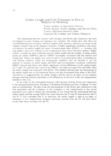Anther Length and Cold Tolerance in Rice in Relation to Breeding
Tropical agriculture research series : proceedings of a symposium on tropical agriculture researches
| ISSN | 03889386 |
|---|---|
| 書誌レコードID(総合目録DB) | AA00870529 |

本文フルテキスト
tars21-_104-104.pdf193.31 KB
The relationship between varietal cold tolerance and flower part characters has been investigated in some Yunnan and Japanese rice varieties. The results show that there are varietal differences in the anther and style lengths. Both anathers and styles are longer in the Yunnan varieties than in the Japanese varieties. A highly significant correlation was observed
between the anther length and empty shrunken grain index (ESGI), i. e., varieties with long anthers were more tolerant to low temperatures than those with short anthers. Highly positive correlations were found between the anther length and the number of phunp pollen grains per anther (NPPGA), and the NPPGA was highly correlated with the relative seed setting rate. Hence, the anther size could be used as a morphological index in breeding for cold tolerant varieties. Under low temperature conditions that are harmful to rice the analysis of variance of anther length and ESGI and environmental correlation coefficients (EMCC) showed that there were highly significant varietal differences in the anther length, (18.11 and 5.78), and that the values of the EMCCs were high (average 0.850 and 0.688), when the anther length was compared with ESGis. This finding indicates that the fluctuations in the anther length due to environmental factors are less pronounced than those of the ESGI. Therefore it is suggested that the anther length could be used as an index of cool summer damage affecting anthesis regardless of the differences in the level of the low temperatures harmful to the crop.
In the study on the relationship between cold tolerance and the flower part characters in the segregated generations, Zhongmu 42/Kunming Xiaobaigu and Xiyu/Yungeng 135 were used as combinations. The data from the determination of the flower part characters in the first generation and the evaluation of the resistance to low temperatures in the second generation were used to deduce the relationship. It was found that the relationship between anther length and the average ESGI was closer between the F4 and F5 than between the F3 and F4. It was concluded that if, in selections, the anther length is used as an index of resistance to low temperatures, pedigree selections starting from the F4 will give better results than those starting from the F3.
between the anther length and empty shrunken grain index (ESGI), i. e., varieties with long anthers were more tolerant to low temperatures than those with short anthers. Highly positive correlations were found between the anther length and the number of phunp pollen grains per anther (NPPGA), and the NPPGA was highly correlated with the relative seed setting rate. Hence, the anther size could be used as a morphological index in breeding for cold tolerant varieties. Under low temperature conditions that are harmful to rice the analysis of variance of anther length and ESGI and environmental correlation coefficients (EMCC) showed that there were highly significant varietal differences in the anther length, (18.11 and 5.78), and that the values of the EMCCs were high (average 0.850 and 0.688), when the anther length was compared with ESGis. This finding indicates that the fluctuations in the anther length due to environmental factors are less pronounced than those of the ESGI. Therefore it is suggested that the anther length could be used as an index of cool summer damage affecting anthesis regardless of the differences in the level of the low temperatures harmful to the crop.
In the study on the relationship between cold tolerance and the flower part characters in the segregated generations, Zhongmu 42/Kunming Xiaobaigu and Xiyu/Yungeng 135 were used as combinations. The data from the determination of the flower part characters in the first generation and the evaluation of the resistance to low temperatures in the second generation were used to deduce the relationship. It was found that the relationship between anther length and the average ESGI was closer between the F4 and F5 than between the F3 and F4. It was concluded that if, in selections, the anther length is used as an index of resistance to low temperatures, pedigree selections starting from the F4 will give better results than those starting from the F3.
| 刊行年月日 | |
|---|---|
| 作成者 | WANG Huaiyi XIONG Jianhua ZHANG Sizhu Yasufumi KUNIHIRO Noboru HORISUE |
| 公開者 | Japan International Research Center for Agricultural Sciences |
| 巻 | 21 |
| 開始ページ | 104 |
| 終了ページ | 104 |
| 言語 | eng |
